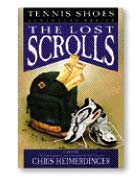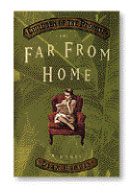By Richard H. Cracroft
As a believing people with a divine destiny, the Latter-day Saints have always regarded their individual and collective histories as manifestations of the hand of the Lord at work in bringing “to pass the immortality and eternal life of man” (Moses 1:39). It is to be expected, then, that the art of the Latter-day Saints in expressing our highest aspirations as a people will be, as Wayne C. Booth asserts, “something you would detect in the very shape of the thing and the kind of experience expressed” (“Art and the Church: Question and Answer Sessions with Wayne C. Booth,” Literature and Belief 1 [1981], p. 27).
“The very shape of” popular Mormon fiction in the past decade has frequently found expression in the form of series. Such fictional series seem to appeal to the Saints’ ingrained sense of being individually significant players in a divine drama directed by an omniscient Father in Heaven intent on accomplishing his purposes for his mortal children. Such series seem to enable the Saint who may sometimes be bewildered by the swirling vortex of his or her own life to identify, trace, and be succored by evidences of the finger of the Lord nudging others’ lives (and thus, by inference, one’s own life)–even when those other lives are fictitious (although founded in the spiritualTruth).
 As one might expect, many of Mormon literature’s fictional series have arisen from attempts to make the standard works more approachable. The Nephite Chronicles is a recent series of six novels by BYU alum Robert H. Moss. These close-clinging but nevertheless fictional re-tellings of events in the Book of Mormon provide a memorable introduction to the book for the youngster in all of us.
As one might expect, many of Mormon literature’s fictional series have arisen from attempts to make the standard works more approachable. The Nephite Chronicles is a recent series of six novels by BYU alum Robert H. Moss. These close-clinging but nevertheless fictional re-tellings of events in the Book of Mormon provide a memorable introduction to the book for the youngster in all of us.
I also enjoy alumnus Chris Heimerdinger’s fun and imaginative Tennis Shoes series. Although the adventures of Jim Hawkins and his children via the time-traveling cavern in the mountains near Cody, Wyo., are only loosely based in scriptural stories and heroes, Heimerdinger stays true in his six novels to depicting the basic conflict between good and evil. The first four novels recount the adventures of Hawkins family members and friends among the Nephites, while the last two–including the latest, The Lost Scrolls (American Fork, Utah: Covenant Communications, 1998; 280 pp.; $13.95)–take the adventurers to Jerusalem in a.d. 70.
Perhaps best known for his prize-winning science-fiction Ender series (Ender’s Game, Speaker for the Dead, Xenocide, Children of the Mind), the first of which is being filmed in Hollywood, BYU alum Orson Scott Card is the most widely known, most imaginative, most literary, most ambitious, and perhaps the best of the LDS writers of literary series. Card’s five-volume Homecoming series, set 40 million years in the future, is, in part, a richly imaginative science-fiction recasting of the journey-in-the-wilderness of Lehi and his family. In The Memory of Earth, the fractious brothers, guided by the Oversoul, retrieve the Index from a powerful kinsman, whom they must slay, and flee into the wilderness. There, amidst brotherly conflict, they heed the Oversoul’s call to return to Earth (The Call of Earth). They seek, eventually find, and make operational ancient spacecraft, which they launch (The Ships of Earth). Returning to Earth (Earthfall), the long-abandoned homeland of their race, they and their posterity struggle (Earthborn) to transform the planet into a fit habitation. Although the Homecoming series speaks to Card’s large science-fiction readership, it engages LDS readers at a different level and in ways that enable fresh insight into universal and LDS religious and social issues.
Now comes Heartfire (New York: Tom Doherty Associates, 1998; 301 pp.; $24.95), the fifth and concluding volume in Card’s remarkable series The Tales of Alvin Maker, his fantasy (not science fiction) recasting of the story of Joseph Smith Jr. (Alvin Smith, blacksmith) and his wife, Emma (Peggy). In a fantasy/alternative America where the Revolution has failed and the conspirators have been hanged, Card follows Alvin, the seventh son of a seventh son and a Maker of white magic, from his birth and youth and continuing struggle with the Unmaker (Seventh Son) through his unfolding mission (Red Prophet) and his apprenticeships as blacksmith and Maker (Prentice Alvin)through his coming-of-age as a Maker with a vision of establishing Crystal City (Alvin Journeyman).
Now, in Heartfire, Alvin journeys north, from Philadelphia and the small country called the United States, to the country of New England, full of his dream of freeing the slaves. Meanwhile, Alvin’s wife, Peggy, journeys into the southern British Crown Colonies and the court of king-in-exile Arthur Stuart at Camelot, where she hopes to avert future warfare and destruction by an audience with King Arthur. Although she is advanced on her course by her knack of reading others’ heartfires, Peggy’s hope of preventing the spread of slavery to the New Countries and averting war among the several American nations is jeopardized by the arrival of Calvin Smith, Alvin’s younger brother–also a Maker, but a profane and perverted Lancelot/Merlin. Card’s wonderful fantasy enables fresh and fascinating looks at American history (albeit skewed) and important issues from slavery to witch trials to human (and gender) equality–and is a lot of fun, to boot.
 Currently many of you are, like me, engrossed in Dean Hughes’ Far From Home (Salt Lake City: Deseret Book, 1998; 492 pp.; $19.95), volume 3 in his Children of the Promise series–so far the only Mormon literature series set in the 20th century. In this third of five projected volumes, Hughes continues his exciting account of the Thomas family of Sugarhouse, Utah, separated into the Pacific and European theaters of World War II. If you haven’t yet taken up this exciting and well-written series, be sure to begin with volume 1, Rumors of War, followed by volume 2, Since You Went Away. Hughes, professor of English at BYU, tells us in an author’s note that “volume 4 will carry the story to the end of World War II,” and volume 5 will conclude the series in “the early postwar period when the soldiers returned and the healing began” (p. 490). Younger readers can be assured that this series is an authentic introduction to how it was to be a Latter-day Saint during all-out war. Older readers, amazed at the welter of detail with which Hughes has packed his story, simply shake their heads and comment, “It’s amazing how right on he is.”
Currently many of you are, like me, engrossed in Dean Hughes’ Far From Home (Salt Lake City: Deseret Book, 1998; 492 pp.; $19.95), volume 3 in his Children of the Promise series–so far the only Mormon literature series set in the 20th century. In this third of five projected volumes, Hughes continues his exciting account of the Thomas family of Sugarhouse, Utah, separated into the Pacific and European theaters of World War II. If you haven’t yet taken up this exciting and well-written series, be sure to begin with volume 1, Rumors of War, followed by volume 2, Since You Went Away. Hughes, professor of English at BYU, tells us in an author’s note that “volume 4 will carry the story to the end of World War II,” and volume 5 will conclude the series in “the early postwar period when the soldiers returned and the healing began” (p. 490). Younger readers can be assured that this series is an authentic introduction to how it was to be a Latter-day Saint during all-out war. Older readers, amazed at the welter of detail with which Hughes has packed his story, simply shake their heads and comment, “It’s amazing how right on he is.”
With the publication of All Is Well (Salt Lake City: Bookcraft, 1998; 716 pp.; $25.95), volume 9 in The Work and the Glory, BYU alum Gerald N. Lund concludes–for now–the LDS Series Supreme, his momentous and unparalleled achievement in re-storying the restoration of the gospel, a.d. 1827–47. In recounting the events of crossing the plains, just 20 years after Joseph and Hyrum first came to the Steed farm near Palmyra, Lund plots the westward course of “The Pioneer Company. The Mormon Battalion. The Donner-Reed Party. The Brooklyn Saints. The Big Company,” and shows how “each has its own unique part to play in the gathering,” and how the Steeds and their extended circle of family and friends are “swept up in grand events just as they have been so many times before”(xi). In his rich fleshing-out of events generally familiar to his readers, Lund masterfully follows his proven pattern of introducing the fascinating detail, the little-known incident, and the largely forgotten men and women who went West–those seemingly insignificant brush strokes of history who enrich the panorama of the Gathering and make apparent the hand of the Master Painter in crafting Zion. All Is Well is a well-crafted, moving, and inspiring concluding panel in the vista called The Work and the Glory. Lund tells us in the preface to this volume that he committed to the late Kim Moe, his inspired researcher and series co-originator, “that once I got the Saints to the Salt Lake Valley, I would take some time off but then would complete the series by doing something with the Steeds in modern times” (xiii). That story, now being lived by us who are the spiritual descendants of the Steeds, the Prophet Joseph, and Brother Brigham, is, as Lund asserts, “a story that needs to be told” (xiii). Indeed. Meanwhile, for the thousands who have ventured and will yet venture on The Work and the Glory journey, Gerald N. Lund has performed a remarkable, blessed, and gracious service.
But as one series closes another begins. Of the writing of series for the Latter-day Saints there appears to be no end. Ron Carter, another BYU alum, has recently initiated a promising new series, Prelude to Glory, which undertakes to complement Lund’s The Work and the Glory. In volume 1, Our Sacred Honor (Salt Lake City: Bookcraft, 1998; 605 pp.; $19.95), Carter recounts, from the point of view of Margaret and John Dunson and their five children–the Steeds of this series–the events of the American Revolution, from Saturday, April 15, 1775, through October 1779. Well told in a manner reminiscent of Lund, and complete with similar endnotes that aid in differentiating fact from fiction, Our Sacred Honor makes clear the role of Providence in shaping the United States and preparing a place and a people for the Restoration.
Richard H. Cracroft, professor of English and director of the Center for the Study of Christian Values in Literature, has taught American, Western, and LDS literature at BYU since 1963.









